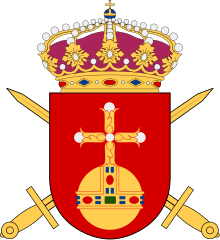Uppland Regiment
| Uppland Regiment | |
|---|---|
|
Upplands regemente (I 8) | |
 Insignia | |
| Active | 1626–1957 |
| Country |
|
| Branch | Swedish Army |
| Type | Infantry |
| Size | Regiment |
| Motto(s) | None |
| Colours | Red and yellow |
| March | "Upplands regementes marsch" |
| Battle honours | Varberg (1565), Narva (1581), Lützen (1632), Warszawa (1656), Fredriksodde (1657), Tåget över Bält (1658), Rügen (1678), Düna (1701), Kliszow (1702), Holovczyn (1708), Helsingborg (1710), Svensksund (1790) |
The Uppland Regiment (Swedish: Upplands regemente), designation I 8, was a Swedish Army infantry regiment that traced its origins back to the 16th century. It was disbanded in 1957. The regiment's soldiers were originally recruited from the province of Uppland, and it was later garrisoned there.
History
The regiment has its origins in fänikor (companies) raised in Uppland in the 1550s and 1560s. In 1617, these units—along with fänikor from the nearby provinces of Dalarna and Västmanland—were organised by Gustav II Adolf into Upplands storregemente, of which eight of the total 24 companies were recruited in Uppland. Upplands storregemente consisted of three field regiments, of which Upplands regemente was one. Sometime around 1623, the grand regiment was permanently split into 3 smaller regiments, of which Upplands regemente was one.
The regiment was officially raised in 1626 although it had existed since 1623. Upplands regemente was one of the original 20 Swedish infantry regiments mentioned in the Swedish constitution of 1634. The regiment's first commander was Nils Brahe. It was allotted in 1682 as one of the first regiments to be so.
The regiment was given the designation I 8 (8th Infantry Regiment) in a general order in 1816. Upplands regemente was renamed Upplands infanteriregemente in 1904 to distinguish it from Upplands artilleriregemente. The regiment was garrisoned in Gävle from 1912. In 1928, the regiment regained its old name. The regiment was disbanded in 1957. The signal regiment Upplands signalregemente was renamed to Upplands regemente in 1974, but does not trace its origins from the original regiment, even though the victory names have been transferred to it.
Campaigns
- ?
Organisation
|
|
Name, designation and garrison
| Name | Translation | From | To | |
|---|---|---|---|---|
| Upplands regemente | Uppland Regiment | 1626 | – | 1904-12-07 |
| Upplands infanteriregemente | Uppland Infantry Regiment | 1904-12-08 | – | 1927-12-31 |
| Upplands regemente | Uppland Regiment | 1928-01-01 | – | 1957-03-31 |
| Designation | From | To | |
|---|---|---|---|
| I 8 | 1816 | – | 1957-03-31 |
| Training ground or garrison town | From | To | |
|---|---|---|---|
| Kronoparken | 17th century | – | 1912-09-09 |
| Örsundsbro | 1680 | – | 1912-09-09 |
| Polacksbacken | 1681 | – | 1912-09-09 |
| Söderby/Uppsala-Näs | 1881 | – | 1912-09-09 |
| Uppsala (G) | 1912-09-10 | – | 1957-03-31 |
See also
References
- Braunstein, Christian (2003). Sveriges arméförband under 1900-talet. Stockholm: Statens Försvarshistoriska Museer. ISBN 91-971584-4-5.
- Holmberg, Björn (1993). Arméns regementen, skolor och staber: en sammanställning. Arvidsjaur: Svenskt militärhistoriskt bibliotek. ISBN 91-972209-0-6.
- Kjellander, Rune (2003). Sveriges regementschefer 1700-2000: chefsbiografier och förbandsöversikter. Stockholm: Probus. ISBN 91-87184-74-5.
- Nelsson, Bertil (1993). Från Brunkeberg till Nordanvind: 500 år med svenskt infanteri. Stockholm: Probus. ISBN 91-87184-23-0.
- Svensk rikskalender 1908. Stockholm: P.A. Norstedt & Söner. 1908.
- Online
- Holmén, Pelle; Sjöberg, Jan (2007). "Swedish Armed Forces 1900-2000". Retrieved 2007-08-20.
- Högman, Hans (2007). "Militaria - Svensk militärhistoria". Retrieved 2007-08-20.
- Persson, Mats (1998). "Swedish Army Regiments". Archived from the original on 2007-08-30. Retrieved 2007-08-20.
- Sharman, Ken (2000). "Swedish military administrative division as per 1629". Retrieved 2007-08-20.
Coordinates: 59°50′27″N 17°38′54″E / 59.84083°N 17.64833°E